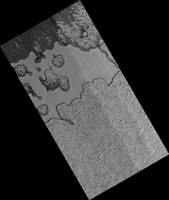
|
Changes of a Happy Crater
- Click the image above for a larger view
- Full-Res JPEG (2880 x 1800) (607.9 kB)
- Full-Res TIFF (2880 x 1800) (13.9 MB)
Caption:

Map Projected Browse Image
Click on image for larger version
We've monitored the so-called Happy Face Crater in the south polar region of Mars for almost a decade. Two images that we took , one in 2011 and the other in 2020, at roughly the same season, show color variations that are due to different amounts of bright frost over darker red ground.
The "blobby" features in the polar cap are due to the sun sublimating away the carbon dioxide into these round patterns. You can see how nine years of this thermal erosion have made the "mouth" of the face larger. The "nose" consisted of a two circular depressions in 2011, and in 2020, those two depressions have grown larger and merged.
Measuring these changes throughout the Martian year help scientists understand the annual deposition and removal of polar frost, and monitoring these sites over long periods helps us understand longer term climate trends on the Red Planet.
The map is projected here at a scale of 25 centimeters (9.8 inches) per pixel. (The original image scale is 24.7 centimeters [9.7 inches] per pixel [with 1 x 1 binning]; objects on the order of 74 centimeters [29.1 inches] across are resolved.) North is up.
Background Info:
The University of Arizona, in Tucson, operates HiRISE, which was built by Ball Aerospace & Technologies Corp., in Boulder, Colorado. NASA's Jet Propulsion Laboratory, a division of Caltech in Pasadena, California, manages the Mars Reconnaissance Orbiter Project for NASA's Science Mission Directorate, Washington.
Cataloging Keywords:
| Name | Value | Additional Values |
|---|---|---|
| Target | Mars | |
| System | ||
| Target Type | Planet | |
| Mission | Mars Reconnaissance Orbiter (MRO) | |
| Instrument Host | Mars Reconnaissance Orbiter | |
| Host Type | Orbiter | |
| Instrument | High Resolution Imaging Science Experiment (HiRISE) | |
| Detector | ||
| Extra Keywords | Color, Crater, Map, Thermal | |
| Acquisition Date | ||
| Release Date | 2021-01-29 | |
| Date in Caption | ||
| Image Credit | NASA/JPL-Caltech/University of Arizona | |
| Source | photojournal.jpl.nasa.gov/catalog/PIA24389 | |
| Identifier | PIA24389 | |
